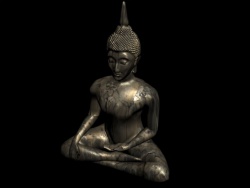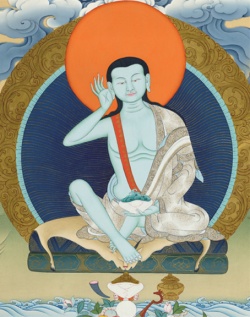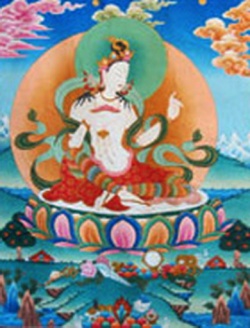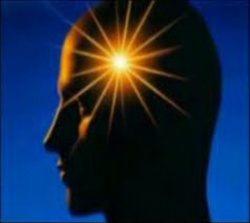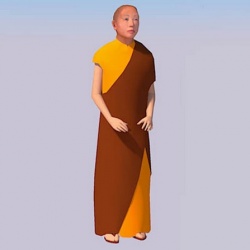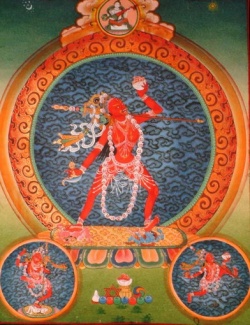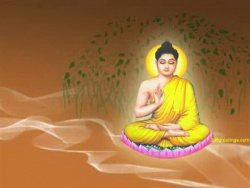The Fourth Turning: A Basic Introduction
A Dialogue between Ken Wilber and Patrick Sweeney
Ken Wilber: Patrick has a really extraordinary history. He went to Colombia University and then Lake Forest College outside of Chicago, and as almost everybody did back then, ended up at the San Francisco Zen Center. He began studying Vajrayana Buddhism in 1983 with Vidyadhara Chogyam Trungpa. Trungpa Rinpoche’s Vajra Regent, his selected heir Osel Tenzin, eventually asked Patrick to be his actual lineage successor and dharma heir, I think around 1989. That happened in a ceremony, and the transmission was confirmed by H. H. Dilgo Khyentse Rinpoche, among others.
When the Regent died in 1990, Patrick went on to study really extensively, and really profoundly—it’s very impressive, his study with other teachers. He studied particularly with Jamgon Kongtrul Rinpoche until his death, he studied with Khenchen Thrangu, he studied with Khenpo Tsultrim, and more recently with Dzogchen Ponlop Rinpoche. All of them have given sanction and blessing to his dharma work and to his being a successor and dharma heir in the lineage of Trungpa Rinpoche.
That part is really wonderful, because Chogyam Trungpa Rinpoche—“Vidyadhara” as he was called, “Knowledge Holder”—whether they knew him directly or not, it’s generally agreed that if there was a Padmasambhava for the West, it was Chogyam Trungpa, who probably did more than any other Tibetan Buddhist teacher to bring dharma to the West and make it available for Westerners.
And now, what all dharma teachers are facing is the fact that we really are looking at how dharma of whatever variety, deep contemplative truth, can get into the modern and postmodern world. So that takes a very special type of person. It’s not only a lineage holder, or simply a teacher in a particular lineage, but somebody that really understands the contributions of the modern and postmodern West to knowledge. Because, while the East, and by the East we really mean contemplative traditions in general, the West also has a very rich contemplative tradition. But while the contemplative traditions were making their really important understandings, the West wasn’t just sitting on its thumbs. It was producing extraordinary understandings everywhere, from neurophysiology to actual genealogy, and the development of consciousness and self. And somehow these two things have to be brought together.
Patrick is one of those who is just uniquely situated, right at the intersection—a fully recognized lineage holder, as well as somebody who has the really deep and rich penetrating understanding of the Western tradition.
And so, we started just rubbing elbows and talking about this stuff. Patrick’s been to seminars, we’ve taught seminars together now. We’ve spent many, many hours discussing how contemplative paths in general, and the extraordinary path of Essence Mahamudra in particular, can be updated into a modern and postmodern framework—keeping all of the really crucial essentials, but also adding some aspects from the West to really produce, I think its fair to talk about, a Fourth Turning in the Wheel of dharma.
And we don’t mean just us, the Buddhist tradition itself talks about major turnings of the Dharma Wheel, major revolutions in the understanding of Buddha-Dharma. And in so doing, it’s really rather unique. Not to say that other traditions don’t have some awareness of this, but Buddha-dharma seemed to understand that Buddha-dharma itself was evolving! Whatever Gautama Buddha did, his successors did more of, and sometimes differently, and brought new stuff into being. So the Three Turnings of the wheel include the original turning that Gautama Buddha himself set into motion. And then the Second Turning was the profound Madhyamaka/Mahayana revolution, initiated primarily by Nagarjuna. Then, in the wake of that, the profound Yogacara revolution. And that was an understanding that, because Emptiness and Form are One, as the Mahayana revolution had shown, then consciousness and its objects are One—and so now instead of getting away from the world of samsara, you can begin to play with the world of samsara: Emptiness and Luminosity are playfully One! And the whole tantric tradition really jumped out of that turning.
And then there really is, I believe, and there are many other teachers as well that are working on this, in the buddhist tradition as well as others, but that there is what can be though of as the Fourth Turning. Might as well call it “Integral”, that’s how so many other people are referring to that as well. And we are working with a lot of teachers here. Of course Traleg Rinpoche, Khenpo Rinpoche, and Patrick—the whole attempt to get dharma into the Western tradition—was in fact the original vision of Trungpa Rinpoche’s Shambhala vision, which was to get dharma into a form that the West can understand.
Of course, in that form we have the support of Shambhala Publications. Sam Bercholz himself has been a steadfast supporter, whether he agreed or disagreed. He didn’t have to agree with all of the things that we were trying to do with Integral, but he has been a staunch supporter of the attempt, and understanding the need to do that is part of the original Shambhala vision. So we’re to the point now where it’s really time to roll up our sleeves and really get into it.
In other words, what are the actual stages in the practices of meditation? What do you do exactly at this stage, and this stage, and this stage? That’s where Patrick is really digging in. And the first seminar that he and all of us really were involved in—but it really was centered around Patrick—was really one of the most astonishing seminars we’ve done, truly one of the highest rated, and I’ve never really seen people relate to it the way they did. There’s something that happens when you have an integral approach to something, using the very best of the contemplative traditions in an Integral or AQAL framework, and it just hits all the right places, so to speak.
So, that’s kind of a long overview on that, but I thought I would give a little bit of Patrick’s background so people knew that we weren’t just talking to somebody who is selling cars and pulled them off the street.
Patrick Sweeney: [Laughs] Well, thank you Ken. You did get everything quite correct except, I only spent my junior year at Columbia University, the other three years I was at. But thank you. Like many people in the late 70‘s—I’m 48 years old—I kind of came into an awareness of fundamental questions of “who am I?” and “what is this world that I have been thrown into?” I came into that in the late 70‘s/early 80’s, and really my inquiry grew out of, you might say, dissatisfaction, desperation. As the Buddha describes it, dukkha, or suffering. A sense of “is this all there is? Is this the life I have inherited? This life that had been given to me by my parents, by the very traditional Catholic Chicago world that I grew up in—what is actually going on here?” Fundamental, root questions throughout my college years. And dealing with the confusion and general suffering of life threw me into asking these fundamental questions, and in finding very specific answers in Buddha-Dharma, and particularly Trungpa Rinpoche’s work.
Prior to being exposed to Trungpa Rinpoche’s work, I was very taken with Alan Watts, in particular Psychotherapy East and West. And then I found Ken’s No Boundary, that probably occurred in 1982 or 83, something like that. Ken has been a great friend to me in terms of this fundamental conversation of “what is going on? What are we as human beings? What is this consciousness that we have? How is it that it interacts with the world? What is the world, anyway? And how are we going to effectively be human in this situation we find ourselves?”
So I guess the only thing I would add to the introduction is that basically, my approach to dharma and to inquiry generally came out of a basic confusion, basic bewilderment about what this human endeavour really is.
Rollie Stanich: Thank you Patrick. I remember from the seminars you gave a beautiful description of the essence of Buddhism in general, and Mahamudra in particular. I wonder if you could share that with us, what you see as the essence of the tradition? Because I think that’s a beautiful segue from the confusion to finding a very beautiful answer, and you are able to elucidate it very well.
Patrick: Ken gave a very beautiful vision of the three yanas. From a three yana perspective, what I found so revolutionary about the Buddha-Dharma is that it’s saying that our basic nature is fundamentally sane, fundamentally awake, fundamentally without difficulty, without problem. Technically, the Mahamudra lineage talks about it as the trikaya or the three bodies of enlightenment—the Dharmakaya, Sambhogakaya, and Nirmanakaya. That the the basic nature of consciousness, the basic nature of mind, what Ken refers to as the always already, one taste nature of mind, is our basic condition. It’s always already available to us, unlike the Christian and catholic conditioning that I went through in my youth, which proclaimed that our fundamental nature was somehow flawed, or rooted in original sin. The great liberating news of Buddha-Dharma for me was that this mind of mine, if I learned how to look and be with it properly, contained all of the positive qualities of human aspiration that I had longed for. And that there was no need to seek outside of my own mind. There was no need to petition either a god or a creator deity, or an external guru figure, to actually awaken me to this basic nature.
So in the Mahamudra tradition, we say that this basic nature is open, and spacious, which is its dharmakaya nature. It is luminous or clear, has cognitive lucidity, which is the sambhogakaya aspect. And it is endlessly responsive, it’s endlessly contact-ful and in touch with reality, spontaneously or effortlessly. And the great tragedy, pointed out by the Buddha’s tradition, particularly by the Mahamudra view of things, is that our life is marked by a continual contraction against this fundamental, open, spacious, lucid, luminous, compassionate nature of mind. We are simply, in a sense, continuously at the mercy of a bad habit—that because we are continuously ignoring the basic nature of our mind, we are creating illusory, false realities, conceptually. And these false conceptual realities are not in accord with how things actually are. And the result of this distortion, the result of this cognitive distortion, the result of this contraction into a subjective pole of experience, and an objective pole of experience, this propensity that we have to view reality in terms of a “self/other” setup then gives rise to, as it says in the tradition, the 84,000 conflicting emotions.
And if these 84,000 conflicting emotions basically work on us, then we’re constantly struggling with reality. We are constantly struggling, constantly arguing with ourselves and arguing with the environment we find ourselves in. This argument turns into activity, or action, or karma. Traditionally, this process of being alienated or estranged from our true nature is described as the process of the basic fundamental nature of mind veiling itself. The dharmakaya nature of mind becomes veiled as the subjective pole of experience. The sambhogakaya, luminous nature of mind, veils itself as the objective pole of experience. That then gives birth to these cognitive obscurations, and gives birth to the emotional and karmic obscurations, which propel us to act based on an illusion, based on our own distorted cognitive framing of reality.
This process of fear-based distortion becomes embedded in what we refer to in the tradition as body, speech, and mind, or what Ken refers to as our gross, subtle, and causal bodies. This mistaking of our true nature, and the positing of a false self as a kind of substitute mode of experiencing reality, this process becomes embedded not just in our mind, but embedded in our energetic body. The tradition talks very eloquently about how the very energetic currents of our body begin to take on a dualistic cognitive tendency or bias. The result of course is that our outer gross, physical body then becomes trapped in a similar qualitative experience of fear, and then we project that on to the world.
In essence, the Buddha’s path is nothing other than dismantling these two veils with their four aspects. When we begin the journey of emulating the Buddha’s path, what we are fundamentally doing is walking the same path as he did, which was to dismantle this subtle and gross body of fear. And we discover, in ever more profound and insightful ways, the true nature of mind and reality. As we know, the Buddha said over and over again, “I teach one thing, and one thing only—suffering (dukkha, dissatisfaction), and its resolution (or its end).”
In my own approach to Buddha-dharma, in my own approach to Buddhism, this refrain, this injunction from the Buddha really has informed every aspect of how I relate to my own practice, and also how I have tried to relate to teaching. The Buddhist teachings are extremely immediate and direct, and they apply to our state of mind, right now. When we are looking at our confused minds, this process of veiling, this process of continuously falling prey to the habit of ignorance, is something that we are doing right now. And we must move directly, move without any hesitation to dismantle this habit.
Ken: I would like to make one quick point about why the subsequent turnings of the wheel of dharma were so incredibly important—particularly, as it turns out, for the modern and postmodern age. If you look at original Buddhism—and it’s still practiced in a form known as Theravada Buddhism today—when people are first introduced to Theravada Buddhism and they hear that there is no self, and no desire, and no grasping, and no pain, it’s very hard to get a handle on what that means. But many people remember seeing monks in Vietnam literally setting themselves on fire in protest, and being in such an absorbed state of consciousness that they did not flinch, they simply burned to ashes sitting in the lotus posture.
That’s a very good indication of the type of liberation that Theravada offered. It offered getting you into a state of what’s generically called Nirvikalpa Samadhi—and most people enter that state each night, a similar state in deep dreamless, formless, sleep. When you are in deep sleep, there is no ego, there is no suffering, there is no grasping, you know how to do that every night. So it’s not that alien once you see that Buddhism is actually a technology of state transformation. And the original Theravada Buddhism was, of course, a rather difficult path to be able to get into states of nirvikalpa samadhi, which lead to nirvana, and nirodh—that “nir” prefix is in a lot of the sanskrit and Pali terminology for Buddhism. Nir means “without”, no qualities, no desires, and so on. A very difficult path. And of course, the idea was to get off of samsara, samsara meaning all the rest of the manifest world, subtle and gross. You’re going to get off that, and you’re going to get into nirvana, and its “bye-bye, and I’m not coming back.”
We have an extraordinary revolution with the second great turning of the Wheel of Dharma and the founding of Mahayana Buddhism, replacing the ideal of the arhat, one who is going “bye-bye”, withe the bodhisattva, who is somebody who vows to get enlightenment as quickly as possible in order to save all sentient beings. But deeper than that is the understanding that Emptiness and Form, or nirvana and samsara, are not-two. That’s an entirely different way, an entirely different end state. It’s no longer being able to get into a state where you can set yourself on fire, although you can still certainly learn to do that. It’s rather that this basic sanity, this basic wakefulness is ever-present, and Emptiness is ever-present, suchness is ever-present. And it just happens to be one with whatever is arising, moment to moment. So now, all of a sudden Buddhism is not a way to get off this world, it’s a way to be fully present in this world. And it’s almost two different religions, the difference is so striking.
What happens is that with Mahayana, and especially Vajrayana, there are all these rich techniques for just allowing emotions to arise, and working with emotions directly and immediately with naked awareness as it arises. Finding the brilliant clarity in your own awareness, moment to moment, and not getting into some state that is away from this world. But simply getting into deeper and deeper capacities for being present, and being open, and being transparent. And the three great bodies of Buddha, as Patrick so well explained, are really a capacity for openness, for clarity, and for compassion, for care. That’s what’s so extraordinary, it’s just an amazing technology for working with the present moment.
Patrick: What you described, again, so beautifully, is exactly the essence of the Mahamudra tradition. The Mahamudra tradition grew out of the tantric revolution that occurred really at the end of the full flowering of Buddhism in India, somewhere between 7th and 11th centuries. That’s when the blossoming of the Mahamudra tradition occurred. With this radical reversal of orientation and toward an understanding of nirvana, nirvana is no longer seen as escape. Nirvana is simply seen as understanding samsara correctly.
Ken: And that’s what is so amazing. Nirvana is not something away from samsara, nirvana is the transparency and the openness of samsara, its innate luminosity and care. And that is just astonishing. It’s absolutely beautiful.
Patrick: In a certain way you could say that the Mahamudra tradition took the basic view of Nagarjuna, the basic view of Prajnaparamita—Second Turning teachings—and as you put it earlier, applied the Yogacara view of buddha nature, took that and then translated it into all three bodies. The essence really of how the Mahamudra tradition became so brilliant was by including the subtle-body experience, and using the energies of the body to so deeply reveal the true nature of mind. And to then work with the three great states, waking, dreaming, and deep sleep, to identify the specific confusion intrinsic to those states, and then apply specific methods to reverse that confusion. Specifically in the Mahamudra tradition, this is referred to as the Six Yogas of Naropa.
The practice of tummo chandali or inner heat reverses the confusion of the basic condition of human beings, which is desire. It reverses not only ordinary desire, but specifically it reverses the unique confusion that arises through sexual desire. The practice of illusory body reverses or transforms the unique confusion of the waking state, which is a subtle aggression—because of the subject/object duality, we are constantly in this semi-subtle seeding mode of trying to get what we want, and keeping away those things that we don’t want. Similarly, the practice of dream yoga was then applied to transforming the unique ignorance that occurs in the dream state. We are basically not lucid dreaming, we are not aware that the appearances and the dreamer are both illusory projections of our mind. And then the fourth root dharma or yoga of Naropa is referred to as the practice of luminosity, which transforms the unique confusion of deep sleep, revealing the ever-present luminous nature of mind.
So in a certain way, the click for me in terms of applying the brilliant state training tradition of Mahamudra to the Integral framework really occurred at one of your Integral Life Practice seminars, where there was this vision that the One Taste experience is, in a sense, the very foundation of the whole Integral model—that without that experience, the rest of it doesn’t really work. Or as you put it, AQAL is nothing other than a map of samsara, and to reverse the identification with those samsaric objects, one must discover this One Taste experience. What occurred to me was that the basic training in this One Taste experience that the Mahamudra tradition is so brilliant at describing, and then creating practices to bring about that transformative experience—applying the state-training methodology of Mahamudra within an Integral Post-Metaphysical framework was what I have been longing to do. To in a sense get beyond any cultural and metaphysical enmeshment around the mythic pre-modern roots of the tradition, and just simply apply what I feel are some of the most efficacious state training techniques—the Six Yogas of Naropa of course, through their fruition—allowing your typical, average, integral student to continue to deepen and deepen and deepen their experience of Always Already, the One Taste nature of mind.
Ken: I think that’s beautiful. To clarify, AQAL is this general integral framework that we use, which has five main elements—we call them Quadrants, Levels, Lines, States, and Types. Quadrants are the fundamental perspectives you can take on any occasion—you can take a 1st-person, “I” perspective, or there is a perspective of a 2nd-person, the person being spoken to, “you”. And when you and Iunderstand each other, “we”have a mutual understanding. And then we can just look at something as an object, as a 3rd-person, or a person not present—a “him/her”, a “them/they”, or an “it”. And so the fundamental perspectives are I, we, and it. And there are a lot of variations on that—it turns out to be the same as the “Beautiful, the Good, and the True”, or “Art, Morals, and Science”, or frankly the “Buddha, Dharma, and Sangha”.
Levels is perhaps one of the most important in terms of integration. Levels refer to vertical stages of development—structures of consciousness, levels in any developmental sequence. And these kinds of levels cannot be seen by introspecting, they can’t really be seen in meditation or contemplation. And it’s why of all the aspects of an AQAL model, the ones that the traditions are particularly not very strong on are these structures of consciousness.
Then there are states of consciousness, the third component. And traditions are extremely rich in understanding of states—unexcelled, as a matter of fact. There are states of consciousness that everybody knows, natural states of consciousness, and the traditions maintain that there are at least four or five major natural states. These are things like waking, dreaming, deep sleep, pure witnessing (called turiya in the sanskrit tradition) and One Taste, turiyatita. I will come back to those in a minute, and come back to levels as well.
Lines refer to developmental lines, and people are aware of these as multiple intelligences, for example, or any capacity or talent that develops in a series of discreet and recognised stages. Evolution itself, going from atoms to molecules, to cells, to organisms—that’s a classic developmental or evolutionary sequence.
The last item is Types. And types are kind of a catch-all, it’s just to remind us that we want to keep our options open, keep looking, keep the mind looking for all the things that need to be included. Types are things that can be applied really to any of the previous elements. Its not uncommon, for example, that in developmental sequences people appreciate looking at the masculine and feminine types of any of these stages. Because often, as Carol Gilligan was probably the most famous to point out, the female develops “in a different voice”, even though she still develops through the same stages, as Carol Gilligan herself pointed out.
Now that framework, which we just sometimes shorten and call “AQAL”—all Quadrant, all Level—the AQAL framework, as Patrick mentioned, is the structure of samsara. In other words, it’s the structure of the manifest universe, the structure of Form, capital “F”. So when the traditions say “Emptiness and Form are not-two”, Emptiness of course is vast unqualifiable reality as such, beyond any terms or qualities, including the one I just said. And that’s why it’s sometimes called Emptiness, because no concepts can grasp it—and most importantly, the idea that it is not a concept is also false! Unfortunately in the West, American Buddhists tend to say that it is “no concepts”, and that you have to get rid of concepts, and thereby landing themselves squarely in Buddhist hell—but thats another story.
So, in a sense, you still do want to get out of samsara, meaning you want to get out of an exclusive identification with the world of form, and find that in you which is infinite. And then I will use some qualifications as metaphors—you want to find the True Self, or the Real Self, or Suchness, or Godhead, or the Abyss, and so on. And then the ultimate goal is to find a union of this infinite Spirit with the entire world of Form.
Now the catch—and this is something that the West has added—is that the world of form is evolving, it’s developing. That is where the levels particularly come in to play. There are levels of development in the various lines that people have. But nonetheless, that entire AQAL framework is, in a sense, a map of the prison floor. And if you have a map of the prison, it helps you with an escape route.
We don’t want people confusing AQAL with Reality—AQAL is relative truth. Absolute truth is your ever-present, pure Suchness, or Thusness, or I AMness, or I-I, or Buddha Nature, or Godhead, and so on.We want to be able to not have any specific identification with the world of Form, other than the entire world of Form itself. When people start studying AQAL, that’s great, because they learn the framework and it helps them index really anything in the manifest world.
And for those levels, I will use Jean Gebser’s names—he was a great pioneer in developmental studies or genealogy—and his general stages of worldviews went from archaic, to magic, to mythic, to rational, to pluralistic, to integral. And those are essentially still true, those work just fine. Of course you can sub-divide those stages all you want, but the real point here is that those are stages of Form, those are stages of samsara’s unfolding. I’ll just say it’s a vertical climb, just as a metaphor—at any point you are developing and climbing that ladder of Form, you can choose to “turn right”, so to speak, and start getting off the world of Form all together. You can let go of all gross forms, you can let go of all subtle forms, you can let go of all causal forms. And once you have done that, you have let go of the entire world of form, and any particular level that might be in it. And that then is pure Emptiness, or pure Openness, or pure Dharmakaya, or pure Godhead, or pure I AM, or pure Abyss.
That “turning right”and getting off the world of Form is what the great contemplative traditions are all about, in terms of a capacity to deliver you a freedom from samsara. And so the Great Liberation is not found just by climbing rungs. The Great Liberation is to get off of rungs altogether, to let go of it all together, to drop it altogether. And that’s exactly what the traditions offer—a time-tested psychotechnology for getting into subtler and subtler states, letting go of grosser and grosser states, until you have let go of states and form altogether.
And that’s what Patrick was talking about when he was saying that integral students would have a way to bring vitality, and life, and basic sanity, and the Great Liberation to whatever you are doing in Form. To make that Form integral. Real integral means being able to use both an understanding of the development of Form, and an understanding of the way you let go Form—you transcend and include it. And it’s that combination that marks the Fourth Turning, because nobody had really understood the developmental levels of form previously, not in a way that the West brought. It’s that levels part that is such an important addition. So with both of them—levels of form and contemplative transcendence of form—putting both of those together, you truly have a very very integral view. One that allows you to both increase consciousness and increase your capacity for Freedom and Fullness.

